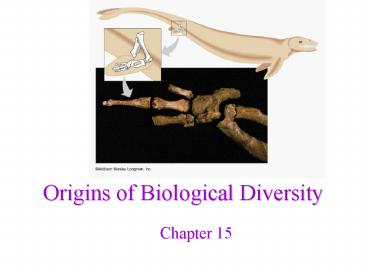Origins of Biological Diversity - PowerPoint PPT Presentation
1 / 12
Title:
Origins of Biological Diversity
Description:
Origins of Biological Diversity Chapter 15 Fossil Record Found in sedimentary rock Show clear relationship for many species over time example: horse Two methods of ... – PowerPoint PPT presentation
Number of Views:175
Avg rating:3.0/5.0
Title: Origins of Biological Diversity
1
Origins of Biological Diversity
- Chapter 15
2
Fossil Record
- Found in sedimentary rock
- Show clear relationship for many species over
time example horse - Two methods of dating
- 1. Relative Dating
- 2. Radioactive Dating
3
Relative Dating
- Determine age of fossils relative to other
fossils in different layers of rock - Rock superposition- younger rock on top of older
rock - Index fossils- fossils which we know when they
lived
determines relative age
4
Radioactive Dating
- Elements such as 14C decay/breakdown at steady
rate into another element - half life- length of time for half the
radioactive atoms in sample to decay - of radioactive atoms in bodies constant through
time - Example carbon-14 decays to nitrogen-14, half
life 5,730 years - Uranium-238 decays into Lead-206, 4.5 billion
years
Determine actual age
5
Geologic Time Scale
- Based on relative and radioactive dating
- Displays evolution of life and geologic events
- Divided into eras
- Precambrian
- Paleozoic
- Mesozoic
- Cenozoic
- Eras divided into periods, periods into epochs
6
Precambrian Era
- 4.6 bya to 580 mya
- 1st prokaryotic cell
- Stromatolites- mats of photosynthetic bacteria
- 1st eukaryotic cell
- 87 of Earths history
7
Paleozoic Era
- 579 mya to 245 mya
- Age of the Invertebrates (marine)
- Jawless Fish then Jawed (1st vertebrates)
- First forests (coal forming)
- Amphibians and reptiles
- Pangea exists
Agnaths
8
Mesozoic Era
- 244 mya to 65 mya
- Triassic- Age of the Reptiles, mammal appear
- Jurassic- dinosaurs flourish
- Cretaceous- first flowering plants, mass
extinction climate change - 135 mya Pangea splits into Laurasia and Gondwana
9
Cenzoic Era
- 64 mya to present
- Age of the Mammals
- Primates evolve
- Modern humans 200,000 years ago
- Plate tectonics, present day positions
10
Comparative Embryology
- Similar developmental stages in vertebrate
embryos - Example, gill pouches and bony tails
11
Comparative Anatomy
VESTIGIAL STRUCTURES
HOMOLOGOUS STRUCTURES
12
Comparative Biochemistry
- Same four bases in DNA
- Same 20 amino acids
- Produce similar proteins (order of amino acids)
- Example, humans DNA 98.2 similar to chimpanzee
- Example, Cytachrome C 104 aas, same in human and
chimp, dog 13 differences, rattlesnakes 20 - Populations evolve, individuals do not































